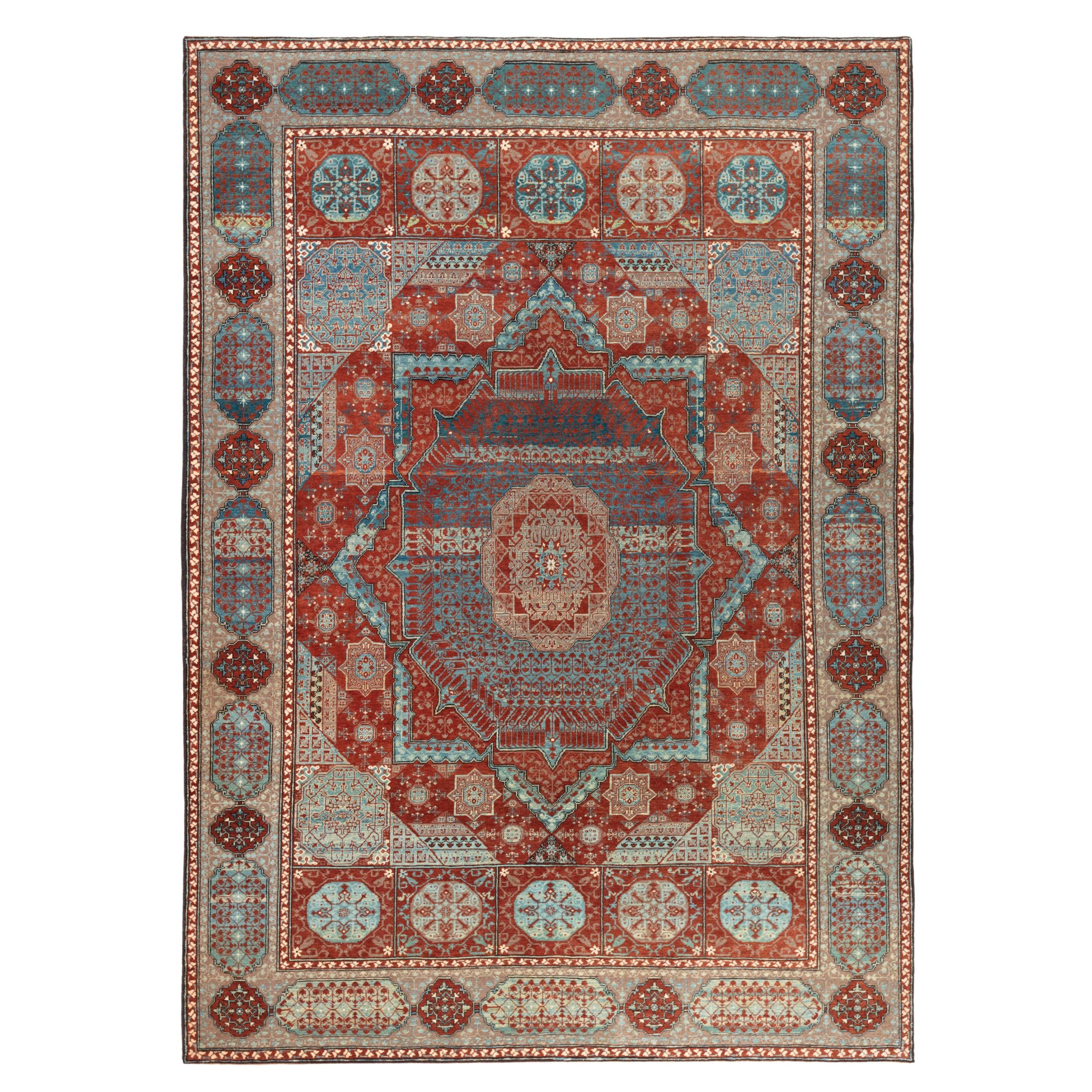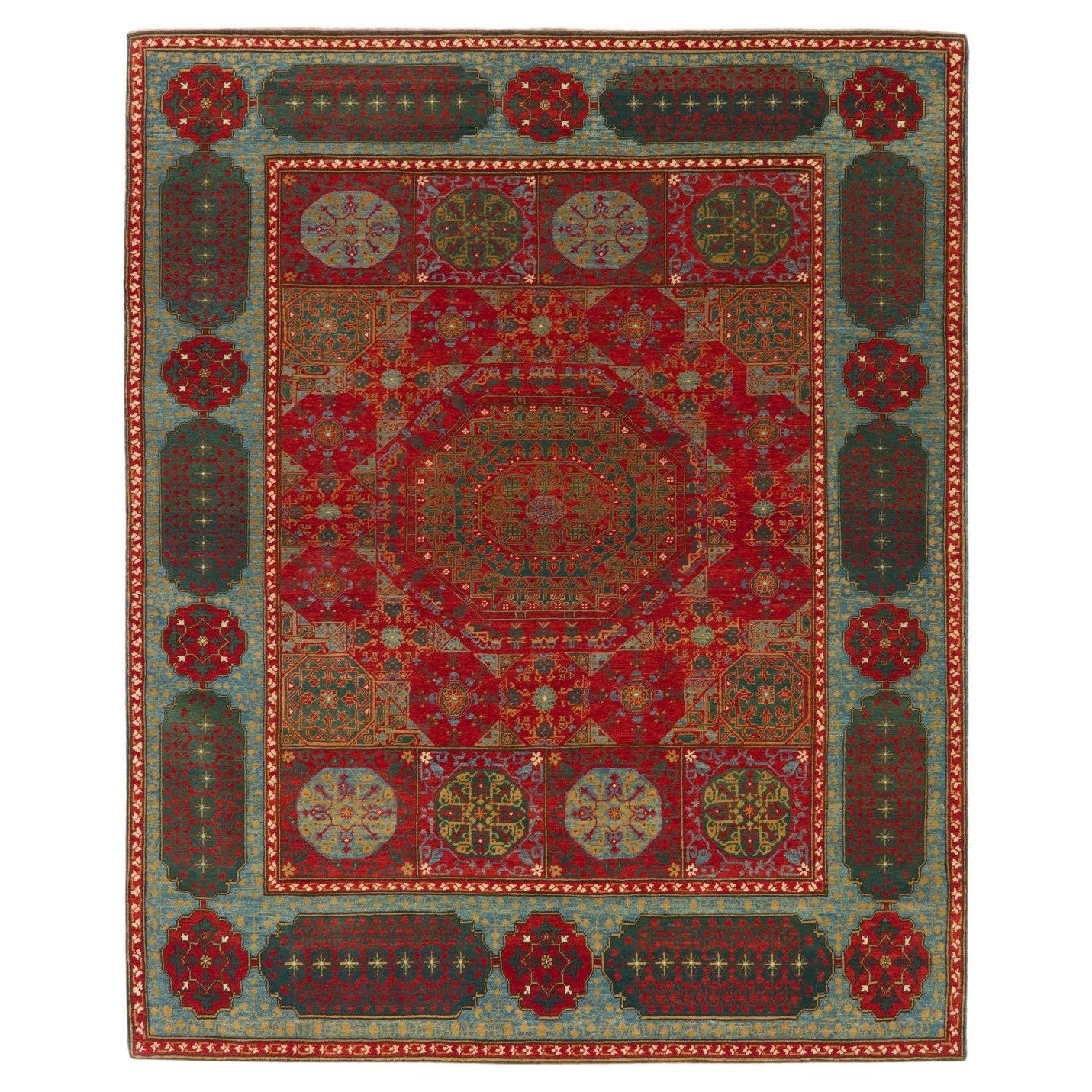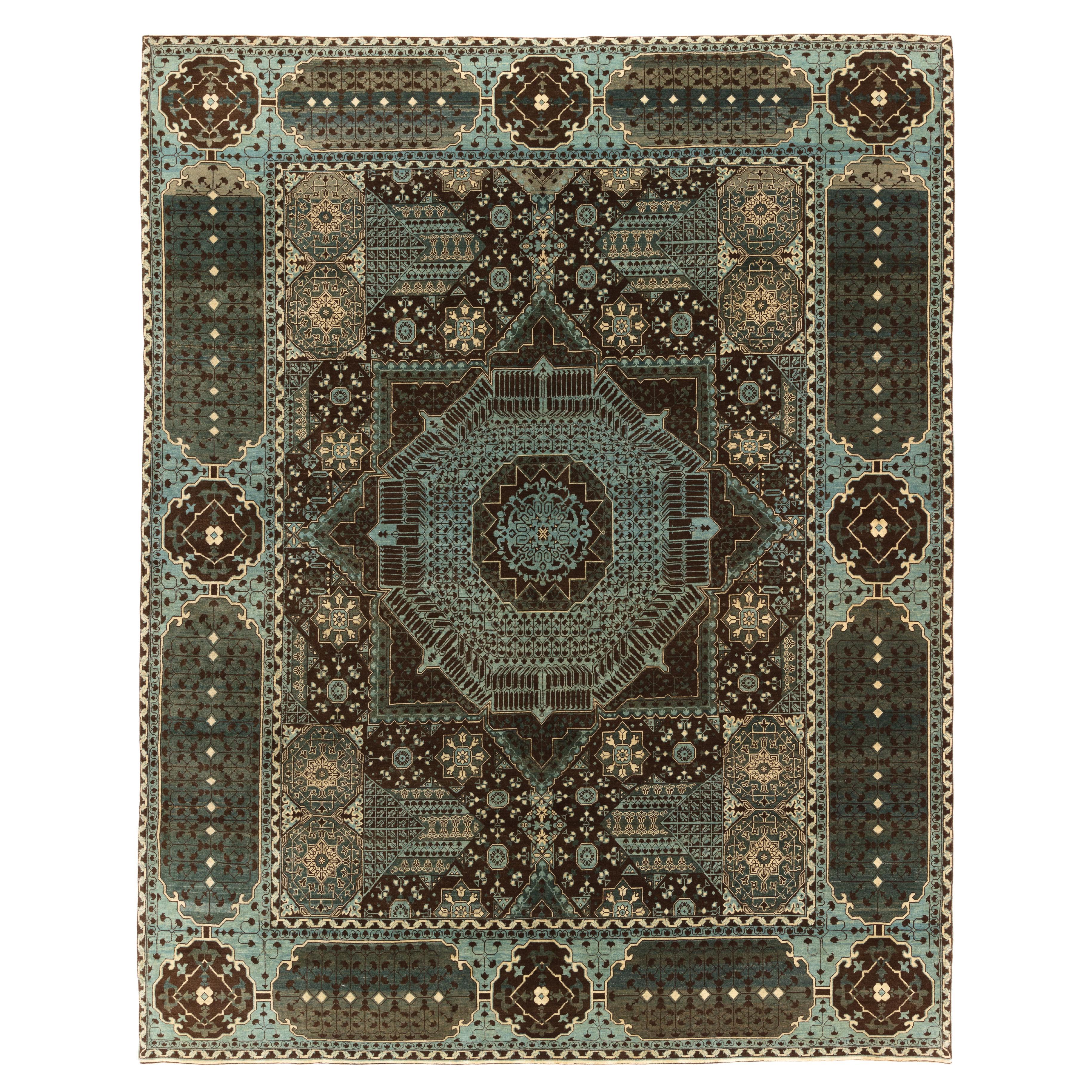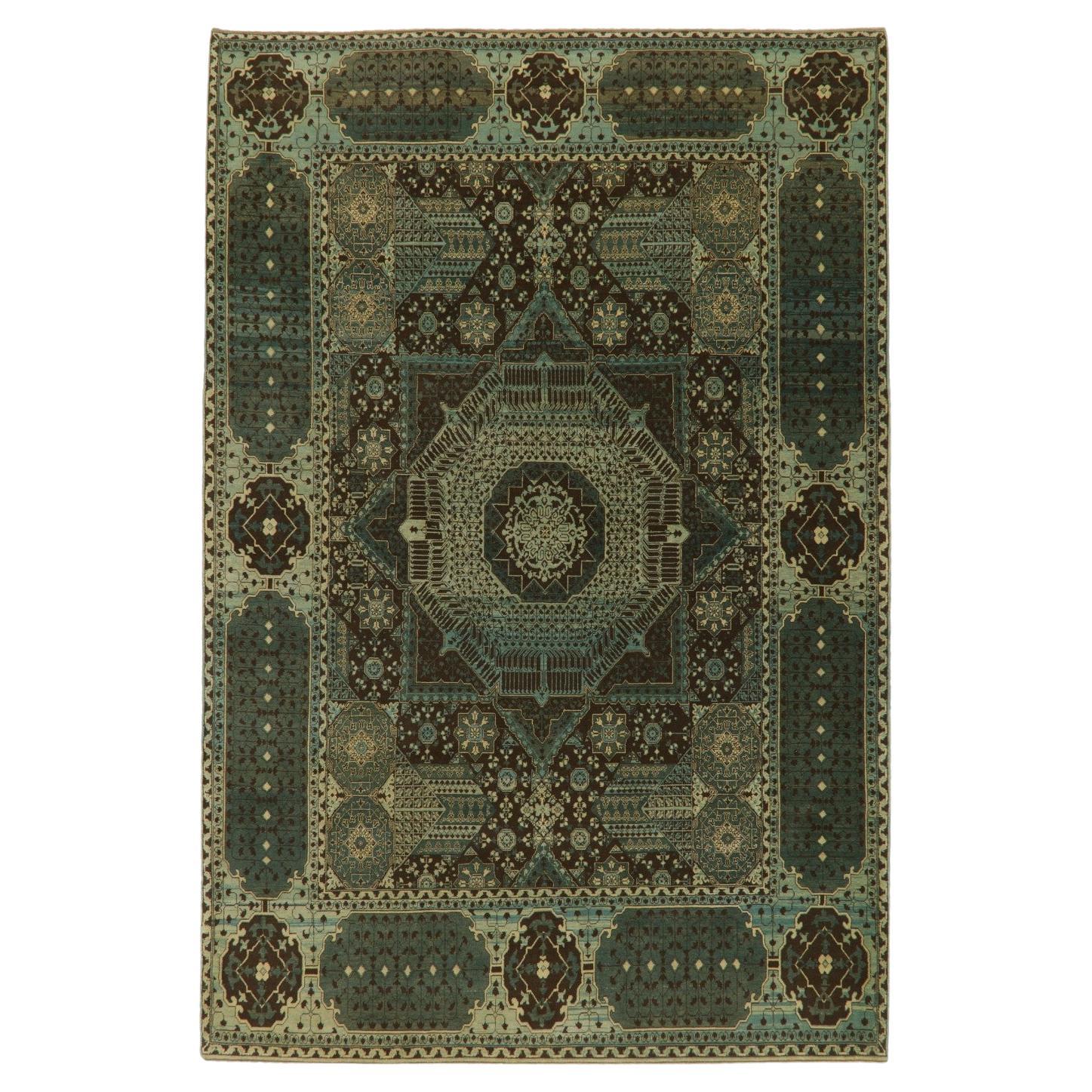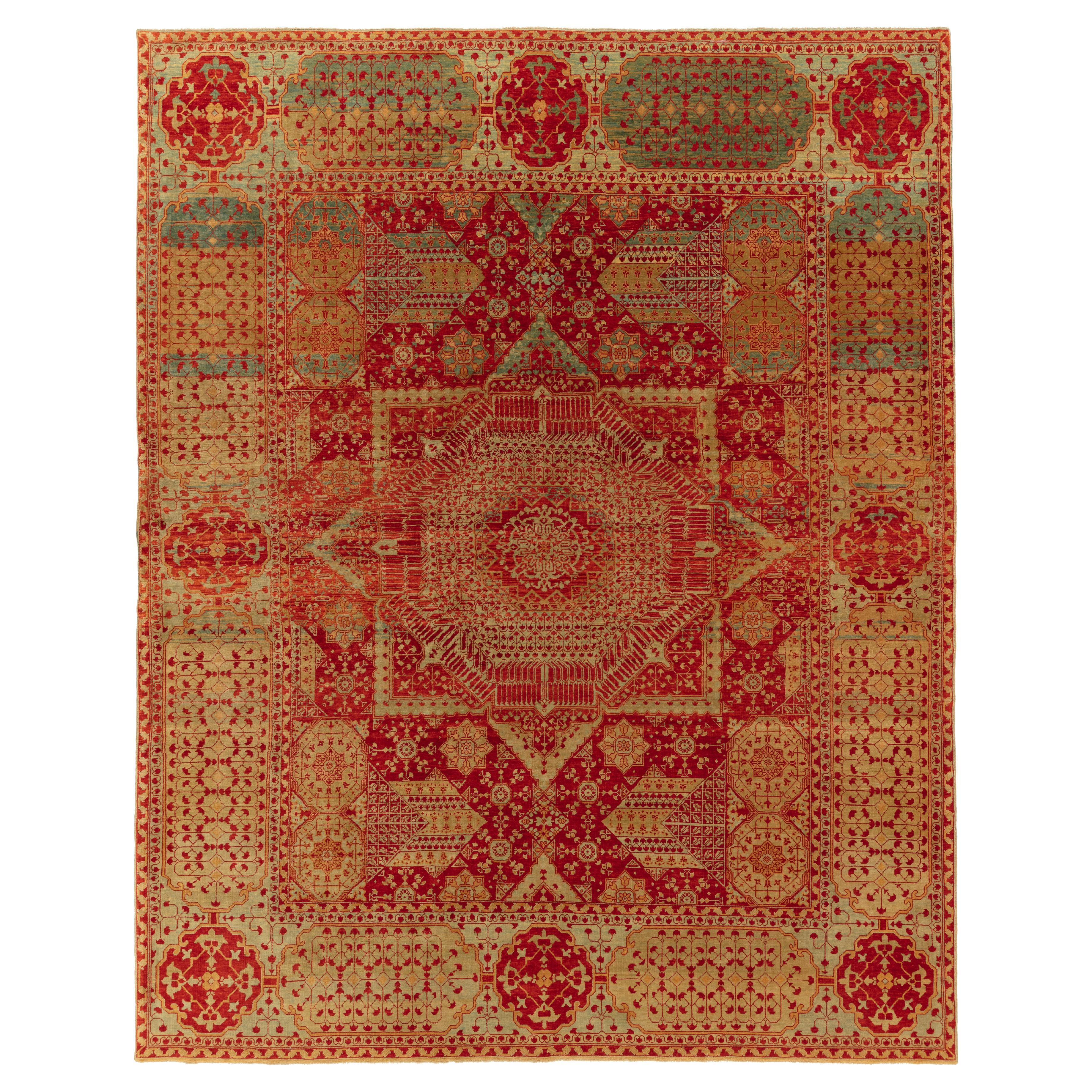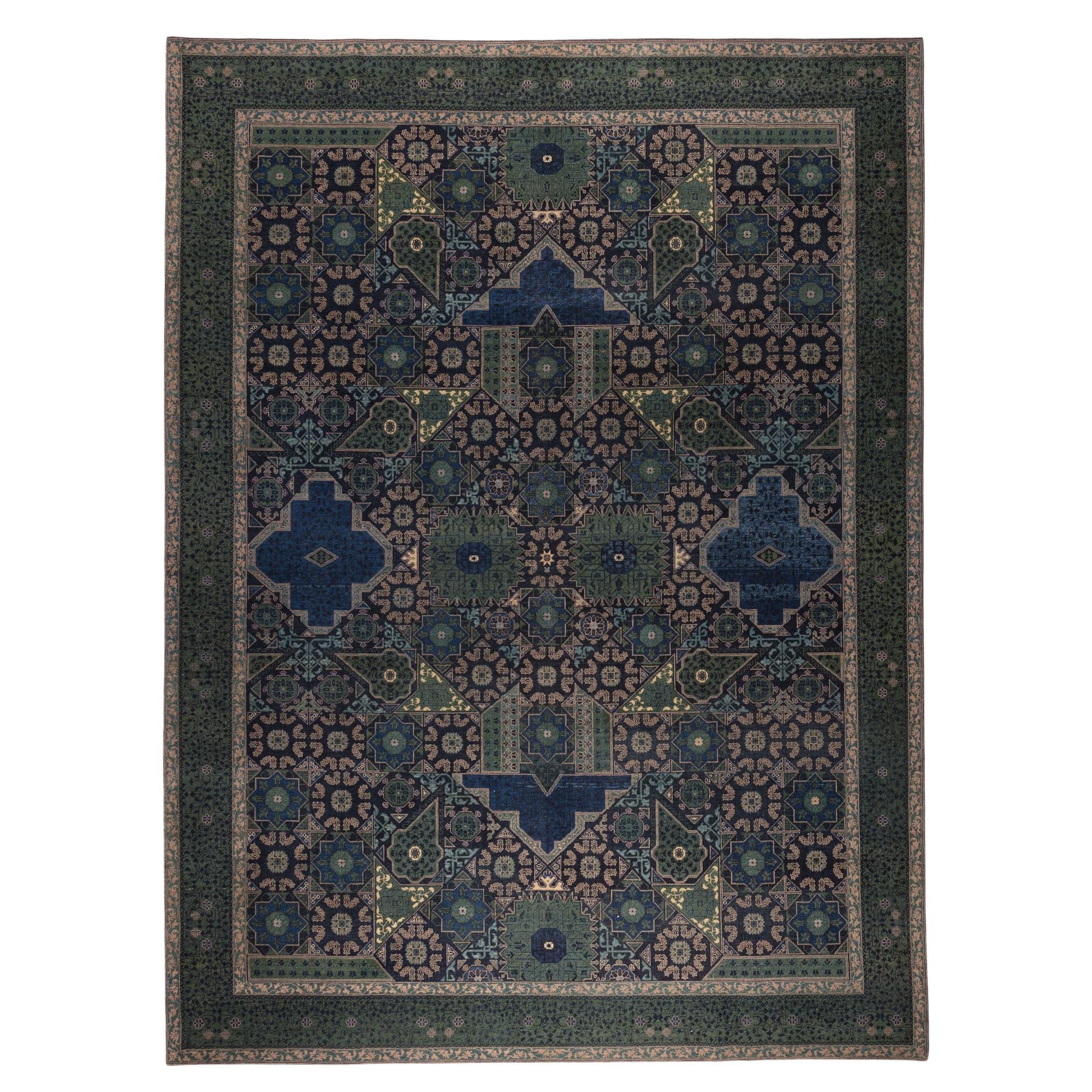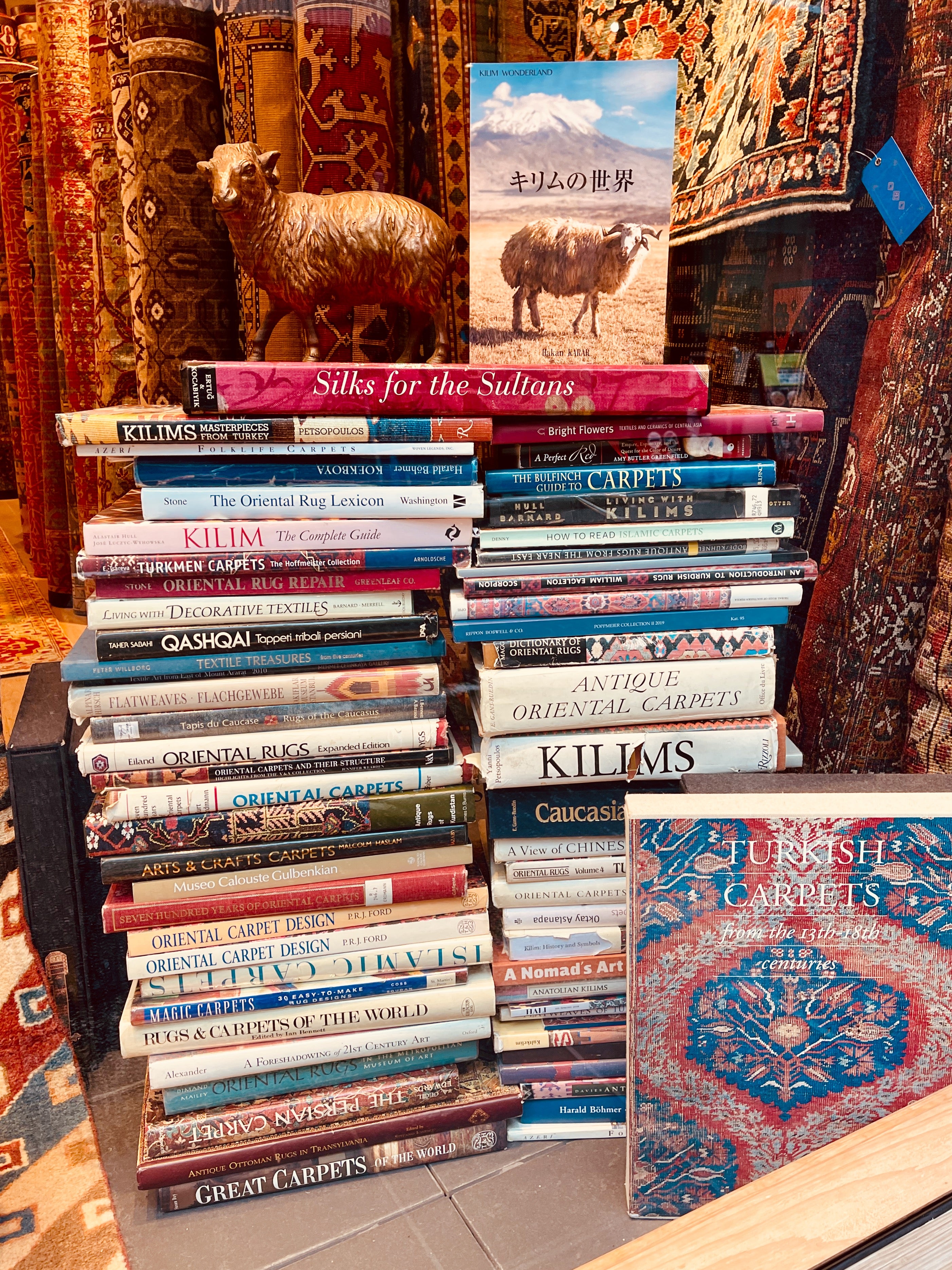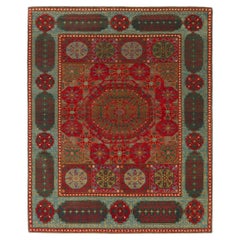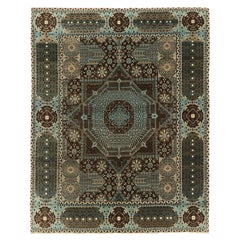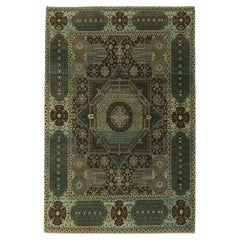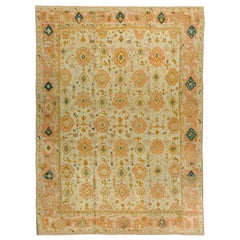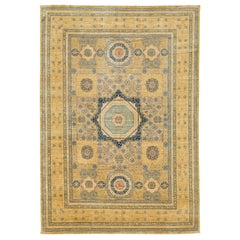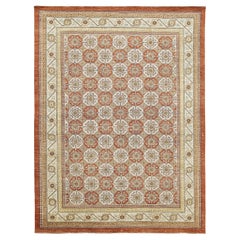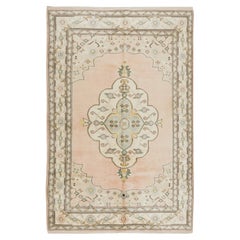Items Similar to Ararat Rugs The Simonetti Mamluk Carpet 16th C. Revival Rug, Square Natural Dyed
Want more images or videos?
Request additional images or videos from the seller
1 of 6
Ararat Rugs The Simonetti Mamluk Carpet 16th C. Revival Rug, Square Natural Dyed
$7,800
£5,895.83
€6,775.36
CA$10,861.45
A$12,082.92
CHF 6,334.02
MX$147,650.34
NOK 80,655.82
SEK 75,926.30
DKK 50,575.50
Shipping
Retrieving quote...The 1stDibs Promise:
Authenticity Guarantee,
Money-Back Guarantee,
24-Hour Cancellation
About the Item
The source of carpet comes from the book How to Read - Islamic Carpets, Walter B. Denny, The Metropolitan Museum of Art, New York 2014 fig.61,62. The five-star-medallion carpet was designed in the early 16th century by Mamluk Sultane of Cairo, Egypt. It is exhibited at The Metropolitan Museum of Art, New York as The 'Simonetti' Carpet. The conventional practice of naming Islamic carpets either after the place they were found ("Niğde Carpet") or after a previous owner ("Anhalt Carpet") in this case memorializes the former Italian owner of this magnificent example of fifteenth-century Cairene weaving under the Burji Mamluk dynasty (1382–1517). The Simonetti Carpet is commonly called a "five-color Mamluk carpet" because of its color palette. The materials (most notably S-spun, or clockwise-spun, wool), dyestuffs (a limited range of colors including a purple-red made from the lac insect), and distinctive repertoire of geometric designs are all characteristic of Mamluk carpets from the period. The width, about ninety-four inches (239 cm), is typical for contemporaneous carpets woven in Cairo. A roller-bar loom was used to make the carpet: the unwoven warps were unwound from a rotating cylindrical wood roller at the top of the loom, and the finished carpet was then wound up around a similar roller at the bottom. This method allowed the same loom to be employed to weave both very long and relatively short carpets of the same width. The Simonetti displays three of the geometric medallion designs usually seen in short Mamluk carpets (two of them repeated, combined in A-B-C-B-A sequence) in one very long, impressive work of art. Mamluk carpets originated in a physical environment that lacked the combination of abundant marginal grazing land and a temperate climate with cool winters that were common to most carpet-weaving areas in the Islamic world. While related to a broader tradition of Turkish weaving centered in Anatolia, far to the north, the designs of these carpets include atypical elements, such as stylized papyrus plants, that are deeply rooted in Egyptian tradition. Their unusual composition and layout probably represent an attempt to develop a distinctive product that could in effect establish a "Mamluk brand" in the lucrative European export market. The uncharacteristic color scheme—devoid of the undyed white pile and employing a limited range of three or five hues in much the same value—also suggests a conscious attempt to create a particular stylistic identity. Also virtually unique in the world of Islamic carpets is the S-spun wool. It has been argued that the tradition of clockwise wool spinning originated in Egypt because of the earlier Egyptian tradition of spinning flax into linen thread. Details of the plant’s botanical structure make it impossible to spin flax fiber in the more common counterclockwise direction utilized throughout the Middle East for wool and cotton.Mamluk carpets with the color combinations seen in the Simonetti are now generally accepted as part of an earlier tradition that has many links to the weaving of Anatolia, Iran, and Syria. The "three-color" Mamluk carpets, well represented in the Metropolitan’s collection, represent a later development that continued well after the Ottoman conquest of Egypt in 1517. Many such carpets may have been produced well into the seventeenth century, and possibly even later. (Walter B. Denny in [Ekhtiar, Soucek, Canby, and Haidar 2011]). The design of the rug is interpreted by our designers with one central star, and soft colors are used for this rug.
Color summary: 4 colors in total;
Pale Green 439 (Chamomile - Indigo)
Falu Red 400 (Madder Root - Henna - Walnut Husk)
Emerald Green 407 (Chamomile - Indigo)
Sunray Color 405 (Henna)
Group: Islamic Rugs Family
Area: Mamluk
Material of Pile: Natural Dyed Hand-spun Wool
Material Warp / Weft: Wool on Wool
Structure: Symmetrical knot on depressed warp inclining to the right
Knots Density: 39x39
Production Place: Southeastern Anatolia – Diyarbakir
Location: Tokyo KNSY
Stock: In Stock
Dimensions:
5 ft 3 in x 9 ft 2 in ( 161cm x 280cm )
- Creator:Ararat Rugs (Manufacturer)
- Dimensions:Width: 63.39 in (161 cm)Length: 110.24 in (280 cm)
- Style:Revival (In the Style Of)
- Materials and Techniques:
- Place of Origin:
- Period:
- Date of Manufacture:2022
- Production Type:New & Custom(One of a Kind)
- Estimated Production Time:Available Now
- Condition:
- Seller Location:Tokyo, JP
- Reference Number:1stDibs: LU8206237887292
ARARAT RUGS
We know and believe that the geography we come from, our past, and our lifestyle are the most important bond between us to carry the oriental carpet art and culture to the next generations along with our core values in our ongoing growth journey.
We are aware that the way to achieve this goal and carry this priceless art and culture to the future depends on a lot of work with all our people every day while adhering to our core values.
For us, art is meaningful in the sense that it brings together various cultures around the world. It is an honor for us that oriental carpet art and culture have been instrumental in this for centuries and that we are a part of this business.
We are tirelessly keeping an eye on auction house information around the world about carpets. New York's Metropolitan, London's Victoria & Albert Museums, and other famous art museums, as well as small specialized museums that house private collections, and books about oriental carpets to collect information on outstanding carpet designs and patterns from around the world. It's our Self-improving and Self-developing culture.
As Turkish Culture of Hospitality, the Kurdish Culture of Generosity, and as Japanese Culture of Business Punctuality; are the most important values that this multicultural background has taught and bequeathed to us. It is essential and valuable for us that you feel this feeling not only by looking at our oriental carpets but from the moment you contact us.
About the Seller
5.0
Platinum Seller
Premium sellers with a 4.7+ rating and 24-hour response times
Established in 1970
1stDibs seller since 2023
55 sales on 1stDibs
Typical response time: 3 hours
- ShippingRetrieving quote...Shipping from: Tokyo, Japan
- Return Policy
Authenticity Guarantee
In the unlikely event there’s an issue with an item’s authenticity, contact us within 1 year for a full refund. DetailsMoney-Back Guarantee
If your item is not as described, is damaged in transit, or does not arrive, contact us within 7 days for a full refund. Details24-Hour Cancellation
You have a 24-hour grace period in which to reconsider your purchase, with no questions asked.Vetted Professional Sellers
Our world-class sellers must adhere to strict standards for service and quality, maintaining the integrity of our listings.Price-Match Guarantee
If you find that a seller listed the same item for a lower price elsewhere, we’ll match it.Trusted Global Delivery
Our best-in-class carrier network provides specialized shipping options worldwide, including custom delivery.More From This Seller
View AllArarat Rugs the Simonetti Mamluk Carpet 16th Century Revival Rug, Natural Dyed
By Ararat Rugs
Located in Tokyo, JP
The source of carpet comes from the book How to Read – Islamic Carpets, Walter B. Denny, The Metropolitan Museum of Art, New York 2014 fig.61,62. The five-star-medallion carpet was d...
Category
21st Century and Contemporary Turkish Revival Turkish Rugs
Materials
Wool, Natural Fiber, Organic Material
Ararat Rugs The Simonetti Mamluk Carpet 16th C. Revival Rug, Square Natural Dyed
By Ararat Rugs
Located in Tokyo, JP
The source of carpet comes from the book How to Read - Islamic Carpets, Walter B. Denny, The Metropolitan Museum of Art, New York 2014 fig.61,62. The five-star-medallion carpet was d...
Category
21st Century and Contemporary Turkish Revival Turkish Rugs
Materials
Wool, Natural Fiber, Organic Material
Ararat Rugs the Simonetti Mamluk Carpet 16th Century Revival Rug, Natural Dyed
By Ararat Rugs
Located in Tokyo, JP
The source of carpet comes from the book how to Rread – Islamic Carpets, Walter B. Denny, The Metropolitan Museum of Art, New York 2014 fig.61,62. The five-star-medallion carpet was ...
Category
21st Century and Contemporary Turkish Revival Turkish Rugs
Materials
Wool, Natural Fiber, Organic Material
Ararat Rugs The Simonetti Mamluk Carpet 16th C. Revival Rug, Square Natural Dyed
By Ararat Rugs
Located in Tokyo, JP
The source of carpet comes from the book How to Read - Islamic Carpets, Walter B. Denny, The Metropolitan Museum of Art, New York 2014 fig.61,62. The five-star-medallion carpet was d...
Category
21st Century and Contemporary Turkish Revival Turkish Rugs
Materials
Wool, Natural Fiber, Organic Material
$18,450
Free Shipping
Ararat Rugs the Simonetti Mamluk Carpet 16th Century Revival Rug, Natural Dyed
By Ararat Rugs
Located in Tokyo, JP
The source of carpet comes from the book How to Read – Islamic Carpets, Walter B. Denny, The Metropolitan Museum of Art, New York 2014 fig.61,62. The five-star-medallion carpet was d...
Category
21st Century and Contemporary Turkish Revival Turkish Rugs
Materials
Wool, Natural Fiber, Organic Material
Ararat Rugs Mamluk Carpet, 16th Century Antique Revival Rug, Natural Dyed
By Ararat Rugs
Located in Tokyo, JP
The source of the rug comes from the book Völker, Angela, Die orientalischen Knüpfteppiche das MAK, Vienna: Böhlau, 2001: 42–5. This rug with the central star was designed in the early 16th century rug by Mamluk Sultane of Cairo, Egypt. It is exhibited at MAK – Museum of Applied Arts, Vienna Austria. As its impressive size, materials, and design quality suggest, the carpet is a product of an accomplished court workshop and likely dates from the late period of the last Mamluk dynasty. The quantity of the colors used speaks for an earlier date around 1500; the delicate vegetal border with leaf tendrils and the characteristic umbrella leaves...
Category
21st Century and Contemporary Turkish Revival Turkish Rugs
Materials
Wool, Natural Fiber, Organic Material
You May Also Like
Handwoven 19th Century Antique Turkish Oushak Rug
By Mehraban Rugs
Located in WEST HOLLYWOOD, CA
Neutral and orange toned antique Turkish Oushak rug handmade in ancient Turkey during the later half of the 19th century. The authentic vintage piece i...
Category
Antique 19th Century Turkish Turkish Rugs
Materials
Wool
Natural Dye Mamluk Design Rug Fable Collection
By Mehraban Rugs
Located in WEST HOLLYWOOD, CA
A majestic Mamluk Design rug from our collection features grandiose medallions and motifs. Borders are well-coordinated with intricate patterns over a goldfield. Perfect for your int...
Category
21st Century and Contemporary Afghan Central Asian Rugs
Materials
Wool
Mehraban Natural Dye Mamluk Design Rug Fable Collection D5557
By Mehraban Rugs
Located in WEST HOLLYWOOD, CA
A phenomenal Mamluk revival that features the vivid tones gold, orange, dusty blue and and cream that gives a space a contemporary feel. Featuring the all-over ornate embellishments ...
Category
2010s Pakistani Central Asian Rugs
Materials
Wool
5.6x8.3 Ft Modern Hand Knotted Turkish Area Rug with Medallion Design, 100% Wool
Located in Spring Valley, NY
A hand-knotted contemporary Turkish rug.
This modern rug has even medium wool pile on wool foundation.
It is made of premium hand-spun sheep and natural dyes, ie. plant based non c...
Category
Early 2000s Turkish Modern Turkish Rugs
Materials
Wool
$990 Sale Price
40% Off
Doris Leslie Blau Antique Turkish Oushak Rug
Located in New York, NY
Antique Turkish Oushak Rug
Size: 12'0" × 21'0" (365 × 640 cm)
This exquisite antique Turkish Oushak rug, handwoven around 1900, beautifully exemplifies the hallmark features of Anato...
Category
Early 20th Century Turkish Oushak Turkish Rugs
Materials
Wool
Hand Knotted Vintage Turkish Wool Area Rug with Medallion Design
Located in Spring Valley, NY
A finely hand-knotted vintage Turkish carpet from 1960s featuring an elegant medallion design. The rug has even low wool pile on cotton foundation. It is heavy and lays flat on the f...
Category
Mid-20th Century Turkish Oushak Turkish Rugs
Materials
Wool, Cotton
$563 Sale Price
44% Off
More Ways To Browse
Star Ottoman
Unusual Ottoman
16th Century Italian Walnut
Spin Display
Iran Book
Art Deco Mid Century Coffee Table
Arts And Crafts Carved Table
Lounge Chair With Stool
Sterling Silver Sterling Silver Tea Service
Sterling Tea Service
Succession Furniture
The Egg Chair
Tiffany Chair
19th Century French Gothic Furniture
American Georgian Furniture
Antique Floral Engraving
Cane Top Table
Canvas And Wood Chair
